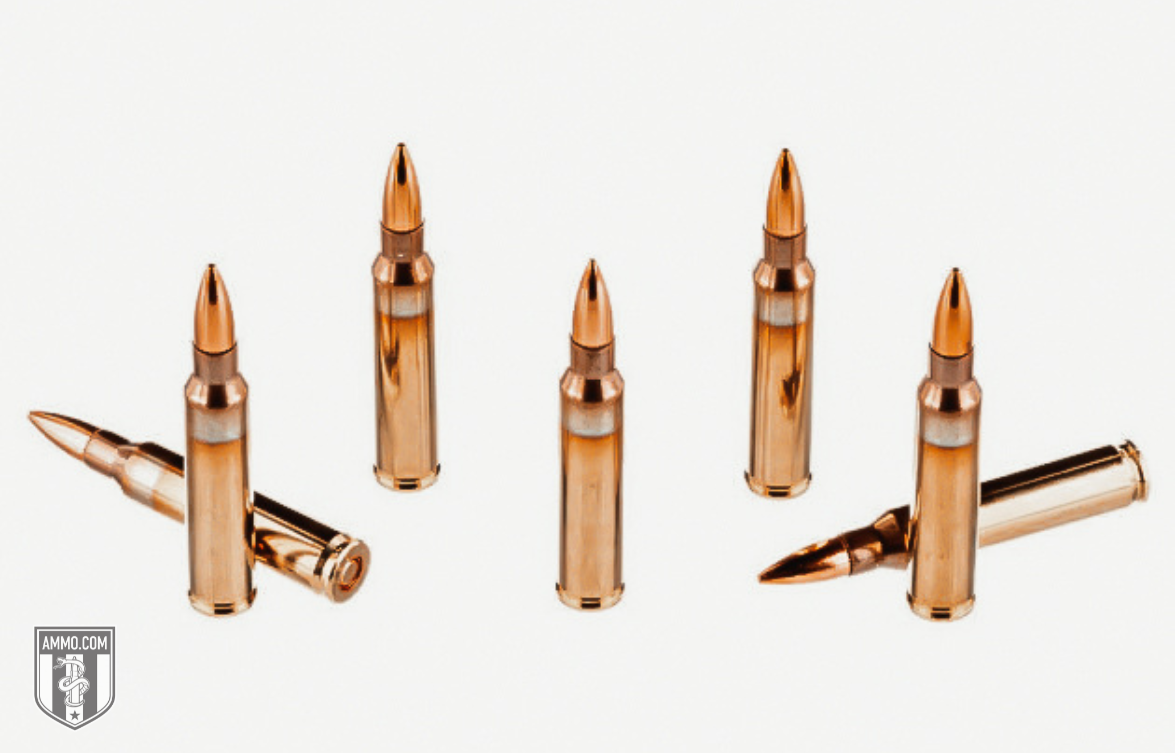5.56 vs. 9mm: Carbine Caliber Conundrum
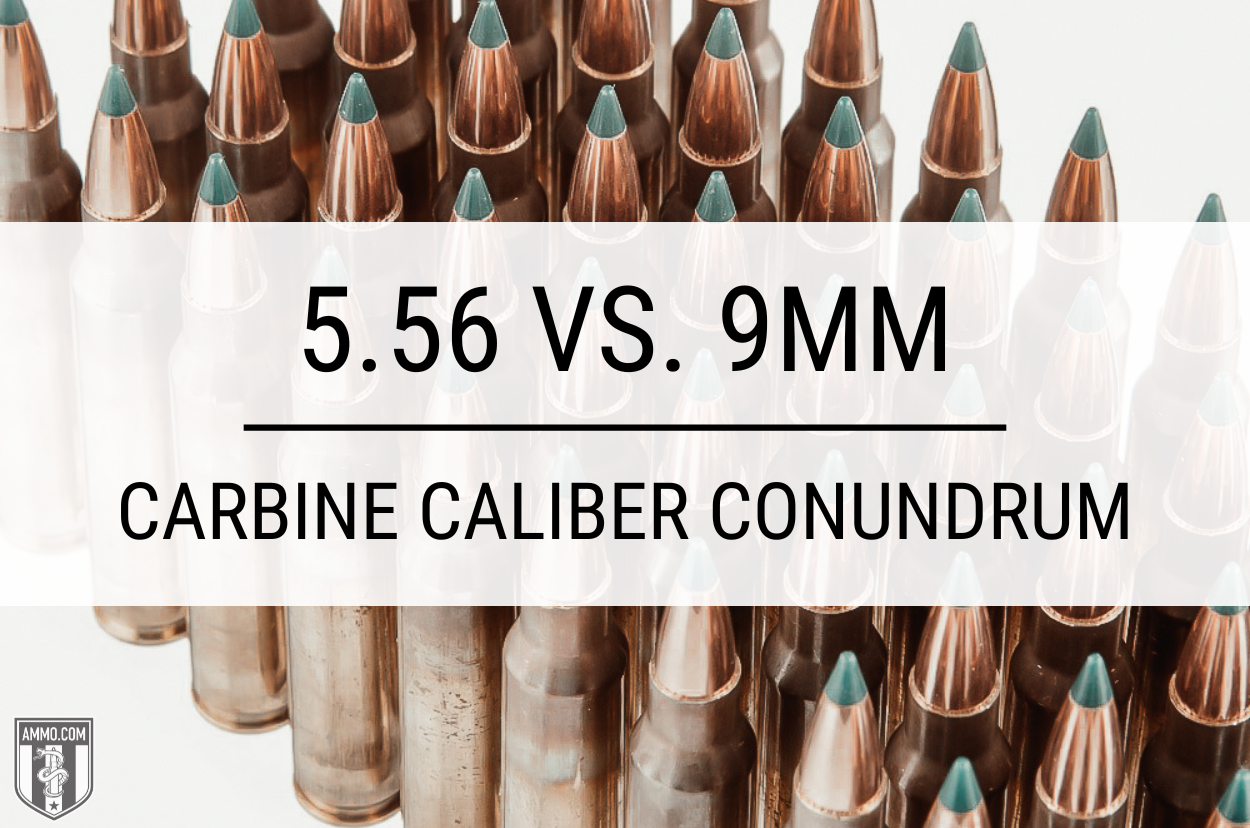 The 5.56 vs. 9mm debate is a tough one. In most respects, the 5.56 cartridge should outperform the 9mm. It’s a rifle cartridge compared to a pistol cartridge, after all.
The 5.56 vs. 9mm debate is a tough one. In most respects, the 5.56 cartridge should outperform the 9mm. It’s a rifle cartridge compared to a pistol cartridge, after all.
On the other hand, when chambered in a carbine, could these cartridges be more similar than they are different?
Let’s find out!
5.56 Compared to 9mm
The 5.56 NATO is a rifle cartridge beloved by many firearms enthusiasts and utilized by militaries worldwide. It is accurate, has low recoil, and is chambered in many firearms. It can be used for hunting in some states, self-defense/home defense, target shooting, and competitive shooting.
The 9mm Luger is a pistol cartridge loved by countless firearms enthusiasts and militaries for different reasons. It’s accurate, has low recoil, and is chambered in revolvers, semi-auto pistols, and carbines. Its primary uses are home and self-defense, target shooting, and competitive shooting.
So which one should you own?
I own firearms chambered in both. But that’s not what this article is about. It’s about reaching a reasoned conclusion by comparing various aspects of the rounds’ performance including their recoil energy, trajectory, accuracy, ballistic coefficient,and suitability for self-defense.
At the end of this article, we will tally the results and announce an everlasting winner.
Technical Specs
As expected, these two cartridges have some drastic differences, making them easy to distinguish at a glance.
The 5.56 NATO bullet has a bullet diameter of 0.224”, whereas the 9x19mm is loaded with a 0.355" diameter bullet. The 9mm is also loaded with heavier bullets than the 5.56 (with rare exceptions, e.g. Liberty Ammunition Civil Defense 9mm 50 grain SCHP).
The 9 mm case and overall length are over 1” shorter than the 5.56x45, which also helps explain the 5.56's more-than-double case capacity. The maximum pressure of the 5.56 is 55,114 psi, whereas the 9mm’s is only 35,000 psi.
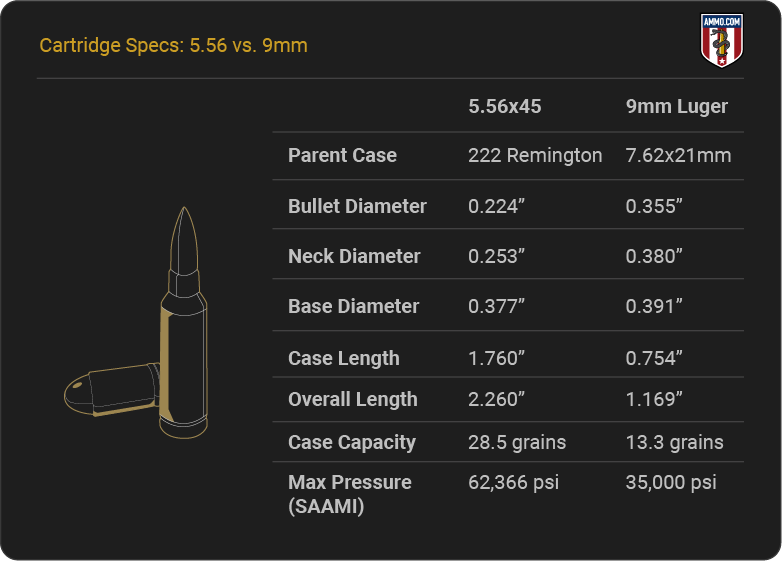
Now that we know just how different these cartridges appear, let’s see how they translate into real-world situations.
What Are The Differences In Recoil Between 5.56 and 9mm Firearms?
Recoil is an important consideration when purchasing a new cartridge. A round with heavy recoil will be more challenging to control and will slow the rate of your follow-up shots. Increased recoil also raises the potential for flinching.
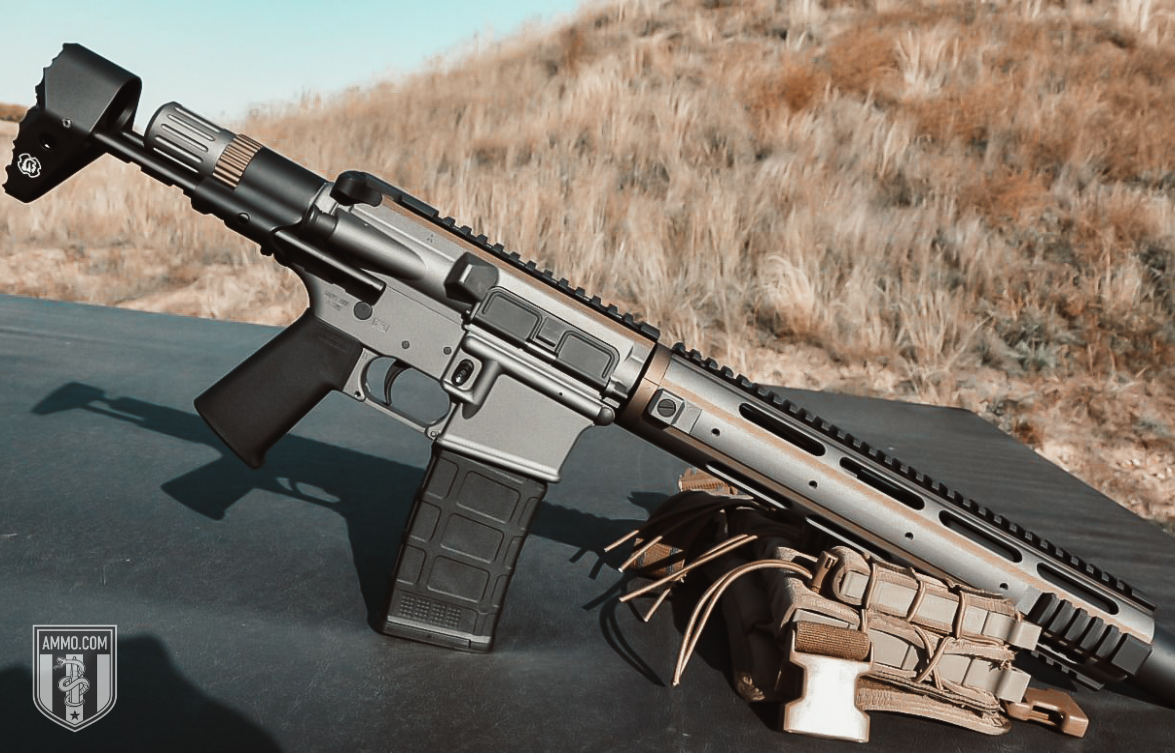
Felt recoil varies from shooter to shooter and depends on firearm choice, stance, and ammo. On the other hand, free recoil is a more objective measure of how hard a cartridge kicks based on firearm weight, muzzle velocity, propellant weight, and bullet weight.
Neither cartridge is known for shoulder-thumping recoil. In fact, shooters often choose both because of their low recoil.
The 9mm has about 4 ft-lbs of free recoil, while the 5.56 NATO has only half a pound more, at 4.5 ft-lbs (the 5.56x45 generates significantly more recoil energy, but a 5.56 rifle’s greater mass proportionately absorbs that recoil). Most shooters won’t notice this difference.
While the 9mm technically has less recoil, it’s not enough to make a drastic difference. This category is a draw.
Trajectory: 5.56 vs. 9mm
As a pistol cartridge, the 9mm has a decent trajectory. After all, most self-defense situations are within 25 yards, and at that point, the bullet’s flight path will remain flat. The 9mm’s trajectory gets slightly flattened out of a carbine as the longer barrel allows more propellant to burn (giving the propellant gasses more time to exert their energy against the bullet), pushing the projectile at a higher velocity.
However, it doesn’t compare to the flat trajectory of the 5.56.
Because the 5.56 NATO is a rifle cartridge, it’s designed to be fired over much farther distances. A 100-yard shot with a 5.56 is relatively simple for most shooters to make consistently. The 9mm can make that shot in the hands of a skilled marksman, but its poor trajectory compared to the 5.56 trajectory will make it much more challenging.
When fired from a firearm with a sight height of 1.5”, a 55 grain 5.56 NATO bullet can easily be zeroed in at 100 yards and will only drop -2.9” at 200 yards.
In contrast, a 124 grain 9mm bullet fired from a handgun with a sight height of 0.5” and zeroed at 25 yards will have a bullet drop of -12.03” at 100 yards.
To be fair, this isn’t an apples-to-apples comparison. The 9mm has two disadvantages. The first is the nature of the handgun’s shorter barrel length; the second is its heavier bullet.
Even when we try to make everything as even as possible, such as firing a lighter 9mm projectile and using a carbine for both cartridges, the 5.56 NATO cartridge will still have a flatter trajectory.
The 5.56 easily wins this section.
Accuracy: 9mm Luger vs. 5.56 NATO
Accuracy is another fickle term, as it depends on many factors. The gun, bullet design, shooter, recoil, trajectory, and shooting conditions all affect a round's accuracy.
We will only consider the recoil and trajectory to keep everything as equal as possible. Recoil is significant because anticipation of it can impact accuracy. Trajectory is significant because the flatter a round shoots, the easier it is to hit the target consistently.
The 5.56 won’t have much advantage within 25 yards. However, its flat trajectory quickly outpaces the 9mm as the distance to the target increases.
The 5.56 is more accurate at longer distances and wins this section.
Ballistic Coefficient: 5.56 vs. 9mm
Ballistic coefficient (BC) measures how aerodynamic a bullet is and how well it resists wind drift.
The 5.56 NATO will generally have a BC around 0.243 (this is the G1 BC of the most common target load (i.e., M193)). This will vary depending on bullet design and bullet weight.
The 9mm BC generally falls between 0.130 and 0.170.
The 5.56 also wins this section, as it has the higher BC thanks to its more aerodynamic projectiles and a muzzle velocity nearly three times higher than the 9mm.
Stopping Power
Once again, we are at another indefinable point. Some shooters claim a round has more stopping power with higher energy. Others claim it’s when the round leaves a bigger hole.
Shooters agree that rifle cartridges have more stopping power than handgun cartridges for various reasons.
Both cartridges have proven to be effective for stopping threats. However, the 5.56 boasts greater stopping power because it has a higher muzzle energy and maintains more energy downrange.
Bullet design also plays a role (a jacketed hollow point (JHP) causes more damage than a full metal jacket (FMJ)), but it’s important to remember that a well-placed shot is always more effective at stopping a threat than a poorly placed shot.
The 5.56 wins this section.
Hunting
I will keep this short: hunting options are limited with the 5.56, but the 9mm is even more limited (some hunters use it for hogs and coyotes). I’m sure someone has shot the buck of a lifetime with it, but it wasn’t created for hunting.
Though there are much better options for hunting than both cartridges, the 5.56 wins this section because it has a farther effective range and is more accurate at long range.
Home Defense: 9x19 NATO vs. 5.56 NATO
This is another case where both cartridges can effectively stop a bad guy, but one is a better option at close range.
I would choose the 9mm as a home defense firearm for several reasons. The first is that over-penetration of walls is less likely. You can choose between a pistol or 9mm pistol caliber carbine (PCC; I prefer a carbine for home defense), and it can quickly end most threats.
While I would use my AR-15 chambered in 5.56 in a pinch, I would be more hesitant to use it because it’s more likely to over-penetrate.
Subsonic rounds are available in both cartridges and are safe to use with a suppressor, whether a 9mm AR pistol or a 5.56 NATO short barrel rifle (SBR). A long gun, such as a bolt-action rifle, is less than ideal in a home defense situation.
The 9mm wins this section.
Ammo & Firearm Cost & Availability
9mm tends to be less expensive than 5.56 ammo; however, 5.56 carbines tend to be cheaper than 9mm carbines.
There are always exceptions, but the 9mm is typically less expensive to purchase and use regularly. Thus, it wins this section.
Reloading
Since both cartridges have been around for many decades, they have abundant reloading supplies and materials available.
Handloading either cartridge will not be a problem. This section is also a draw.
5.56 NATO Ballistics vs. 9mm Ballistics
Another way to understand the differences between these cartridges is to see how they theoretically perform using ballistics tables.
This is for all the numbers lovers!
5.56 Ballistics
If you just can’t get enough data, check out our 5.56 ballistics tables!
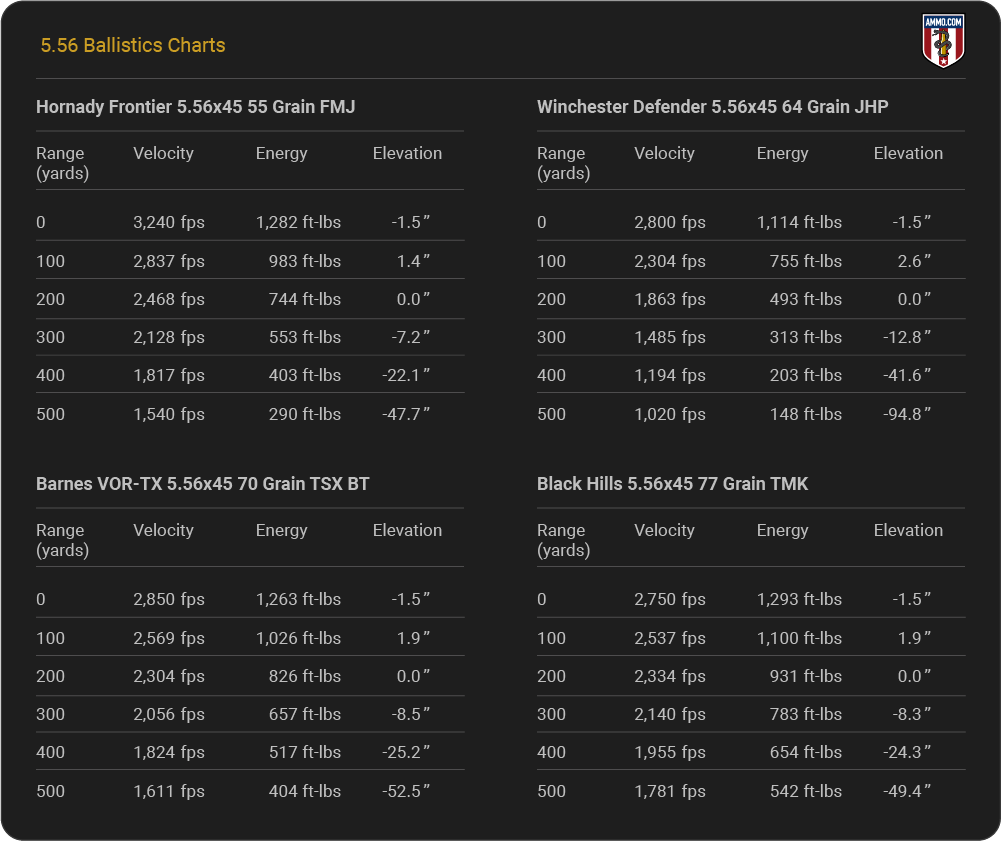
9mm Ballistics
If you just can’t get enough data, check out our 9mm ballistics tables!

5.56 NATO Brief History
In 1957, the U.S. Continental Army Command (CONARC) asked Eugene Stoner for a scaled-down version of the AR-10. With the request, CONARC also needed a new rifle round. The military wanted the following requirements:
- Maintain supersonic velocities at 500 yards
- Penetrate Army-issued steel helmet (body armor) at 500 yards
- Penetrate a .135-inch steel plate at 500 yards
- Reach the accuracy and ballistic performance of M2 ball ammunition
- Wound as efficiently as the M1 Carbine
Earle Harvey crafted the original 5.56 cartridge from the .222 Remington. He lengthened the case for more powder and called it the .224 Springfield. However, he could not finish his work with the cartridge due to conflicting interests at Springfield Armory.
Stoner then turned to Frank Snow and Robert Hutton to finish the job. They collaborated on a 55 gr bullet with a muzzle velocity of 3,300 fps that met CONARC’s requirements.
In 1959, the AR-15 and the 5.56x45mm cartridge were ready for testing. By 1964, the U.S. Army officially adopted the 5.56mm Ball Cartridge (M193), commonly called 5.56 NATO, for its newest firearm, the M16.
Since then, law enforcement agencies and militaries worldwide have opted for the cartridge. It is a favorite rifle caliber for many U.S. civilians for target shooting and home defense.
9mm Luger Brief History
Georg Luger created the 9mm Luger over 100 years ago as a pistol round. It first gained popularity in Europe before reaching the United States.
The popularity of the 9mm exploded in the 1980s and 1990s when reliable semi-auto pistols became available from manufacturers such as Glock, Ruger, and Smith & Wesson.
Since then, the 9mm round has gained esteem and is often used for concealed carry over the more powerful 45 ACP.
Parting Shots: 5.56 vs. 9mm
Now that you’ve finished reading our 5.56 vs. 9mm comparison, you’ll know that the 5.56 NATO won five sections (trajectory, accuracy, BC, stopping power, and hunting), and the 9mm won two sections (home defense and cost), while two sections were a draw (recoil and reloading).
The 5.56 wins!
However, that doesn’t automatically mean it’s your best choice. Consider the categories carefully, and then decide for yourself: is the 9mm or 5.56 the better cartridge for your situation?
Ammo Comparisons
- .308 vs 5.56
- 6.5 Creedmoor vs .308
- .300 Blackout vs .308
- .300 Win Mag vs .308
- .243 vs .308
- .308 vs .30-06
- 7mm-08 vs .308
- .270 vs .308
- 7.62x39 vs .308
- .223 vs .308
- .338 Lapua vs .308
- .380 ACP vs 9mm
- .223 vs 5.56
- .300 Blackout vs 5.56
- 9mm vs 45 ACP
- 9mm vs 40 S&W
- .357 SIG vs 9mm
- 10mm vs 9mm
- 9mm vs 9mm Luger
- .243 vs .270
- .300 Win Mag vs .30-06
- .270 vs .30-06
- .40 vs .45
- 38 Special vs 357
- 9mm vs 40 vs 45
- 5.56 vs 7.62x39
- 338 Lapua vs .30-06
- .30-30 vs .30-06
- 300 PRC vs 338 Lapua
- .30-06 vs 7mm
- 300 Win Mag vs 338 Lapua
- 300 PRC vs 300 Win Mag
- 300 WSM vs 300 Win Mag
- 338 Win Mag vs 338 Lapua
- 12 Gauge vs 20 Gauge
- 10mm vs 357 Mag
- .30-30 vs 7.62x39
- 224 Valkyrie vs 22-250
- 17 HMR vs 22 Mag
- 7.62x39 vs .300 Blackout
- 45 ACP vs 45 Auto
- 45-70 vs 30-30
- 300 Blackout vs 223
- 357 Magnum vs 9mm
- 350 Legend vs 300 Blackout
- 224 Valkyrie vs 223
- 45 ACP vs 38 Super
- 6.5 Grendel vs .308
- 17 HMR vs 22 LR
- 10 Gauge vs 12 Gauge
- 22-250 vs 223
- 45 Colt vs 45 ACP
- 350 Legend vs 30-30
- 5.7x28 vs 223
- 5.7 vs 9mm
- 5.56 vs 5.7
- 22 vs 9mm
- Buckshot vs Birdshot
- 450 Bushmaster vs 308
- 450 Bushmaster vs 223
- Buckshot vs Slug
- 6.5 Grendel vs 5.56 vs 223
- 6mm ARC vs 6.5 Grendel
- 44 vs 45
- 458 SOCOM vs 5.56
- 357 vs 44
- 32 ACP vs 380
- 300 Win Mag vs 338 Win Mag vs 338 Lapua Mag
- 450 Bushmaster vs 458 SOCOM vs 50 Beowulf
- 6mm Creedmoor vs 6.5 Creedmoor
- TMJ vs FMJ
- 44 Special Vs 44 Magnum
- 45 90 vs 45 70
- 6.8 Western vs 6.8 SPC
- 50 Beowulf vs 50 BMG
- 26 Nosler vs 6.5 PRC
- 28 Gauge vs 410
- 6.8 SPC vs 5.56
- 6.8 SPC vs 6.5 Grendel
- 6.8 Western vs 7mm Rem Mag vs .28 Nosler
- 6.8 Western vs 6.5 Creedmoor
- 22 Hornet vs 223
- 6.8 Western vs 6.5 PRC
- .410 vs 12 Gauge
- .410 vs 20 Gauge
- 22 LR vs 22 Mag
- 6mm ARC vs 243
- 7mm-08 vs 270
- 243 vs 6.5 Creedmoor
- Nickel vs Brass Casing
- 204 Ruger vs 223
- 50 Beowulf vs 5.56
- 260 Remington vs 6.5 Creedmoor
- 6mm Remington vs 243
- 28 Nosler vs 300 PRC
- 50 Beowulf vs 50 AE
- 22 Nosler vs 22-250
- 450 Marlin vs 45-70
- 300 Win Mag vs 300 Norma
- 458 SOCOM vs 300 Blackout
- 38-55 vs 45-70
- 22 Hornet vs 22 LR
- 300 Norma vs 338 Lapua
- 338 Lapua vs 50 BMG
- 28 Nosler vs 300 Win Mag
- 28 Nosler vs 6.5 Creedmoor
- 204 vs 22-250
- 458 SOCOM vs 45 70
- 44 40 vs 45 70
- 6.8 SPC vs 6.5 Creedmoor
- 450 Bushmaster vs 30-06
- 7mm Rem Mag vs 300 Win Mag
- 30 Carbine vs 223
- 25-06 vs 30-06
- 26 Nosler vs 28 Nosler
- 16ga vs 12ga
- 30 06 vs 7.62 x54R
- 9mm Makarov vs 9mm Luger
- 350 Legend vs 223
- 30 Carbine vs 5.56
- 6.5x55 vs 6.5 Creedmoor
- 6.5 Creedmoor vs 270 vs 25-06
- M193 vs M855
- 450 Bushmaster vs 458 SOCOM
- 6.5 Grendel vs 6.5 Creedmoor
- 350 Legend vs 5.56
- .277 Fury vs 6.8 SPC
- 277 Fury vs 300 Win Mag
- 10mm vs .45 ACP
- 277 Fury vs 223
- 6.8 SPC vs 300 Blackout
- 6.5 PRC vs 6.5 Creedmoor
- 277 Fury vs 308
- 277 Fury vs 6.5 Creedmoor
- 350 Legend vs 450 Bushmaster
- 277 Fury Vs 5.56 NATO
- 10mm vs 40S&W
- 32 ACP vs 9mm
- 32 Special vs 9mm
- 8.6 Blackout vs 300 Blackout
- 30 Super Carry vs. 9mm
- 5.56 vs 9mm
- .50 Action Express vs 9mm
- 7.62x25 vs. 9mm
- 10mm vs 44 Magnum
- 300 Blackout vs 300 Win Mag
- 6.5 Grendel vs 300 Blackout
- 460 Rowland vs 10mm
- 300 RUM vs 300 PRC
- 300 Norma vs 300 PRC
- 45 GAP vs 45 ACP
- 7mm PRC vs 300 Win Mag
- 300 PRC vs 6.5 Creedmoor
- 300 PRC vs 308
- 357 SIG vs 357 Mag
- 7.62x39 vs 7.62x51
- 243 Win vs 223 Rem
- 30 Nosler vs 300 PRC
- 6.5 Creedmoor vs. 30-06 Springfield
- 450 S&W vs. 44 Magnum
- 6.5 Creedmoor vs. 300 Win Mag
- 454 Cassull vs. 45-70 Govt
- 454 Cassull vs. 44 Mag
- 7.62x54r vs. 308 Winchester
- 22 ARC vs. 223 Rem
- Subsonic vs. Supersonic Ammo

